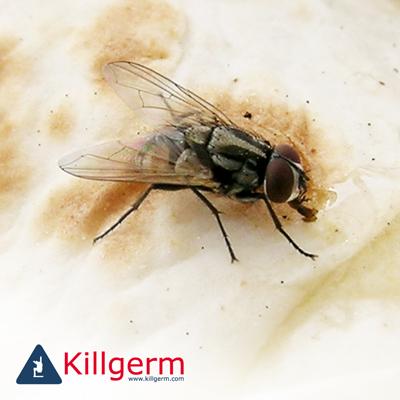“If you followed a fly for a day you wouldn’t eat for a week” is favourite saying of staff at Cleankill Pest Control.
There are more than 110,000 species of flies with the largest being around 6cms long and the smallest only around 0.15mm long. Some are more bothersome than others – depending on the season – and some carry more germs than others.
In late summer if staff in top-floor offices are complaining about flies – or your loft space is overrun with insects – it’s probably cluster flies.
Cluster flies such as Common cluster fly Pollenia rudis are ‘field’ flies – they lay eggs in the soil and the larvae burrow into earthworms where they pupate. As the weather becomes cooler, they seek out shelter in nooks and crannies in buildings to hibernate in large numbers. Their favourite places are roof spaces and lofts and people living in houses in the country are often plagued with swarms of cluster flies in their lofts.
Normally, several thousand flies will cluster together – hence the name cluster flies. They will usually infest the highest warm point available – and this is often the top floor of offices or loft spaces in people’s homes.
Cleankill Pest Control’s Managing Director Paul Bates explains: “As cluster flies don’t breed indoors, controlling them outside is impractical. It’s often impossible to keep flies from entering premises, no matter how well sealed or modern the property is. The flies enter through air vents, breathing points in mortar, roof tiles and even through gaps in modern double glazing.”
Insecticidal spraying around window and door frames and other entry points can help. Once flies are inside, control can be achieved with a range of insecticides and electronic ultra-violet fly machines.
While there is a specific species of Common cluster fly, there are other species of swarming flies which overwinter.
The life cycle of the cluster fly is very much dependent on the prevailing weather conditions and, in this country, two generations a year are usual but, in hot summers, up to four generations per year are possible.
Curiously, a single house or one building in a row of similar buildings is often chosen year after year for this clustering phenomenon.
While cluster flies can be a nuisance, the do not pose a risk to human health and their presence should not be taken as evidence of poor hygiene.
The typical cluster fly is about 7mm long and has distinct lines or stripes behind the head, short golden-coloured hairs on the thorax and irregular light and dark grey areas on the abdomen. Cluster flies are typically slow-moving. Eight species are found in Britain and 31 in Europe.
For further information call 0800 056 5477.
